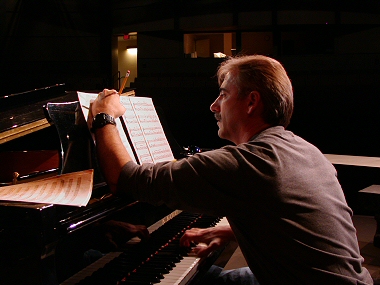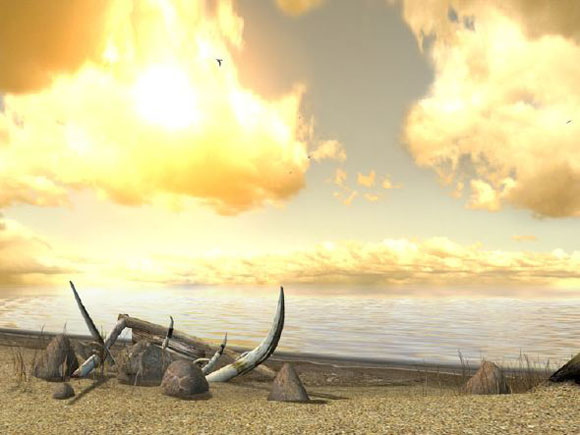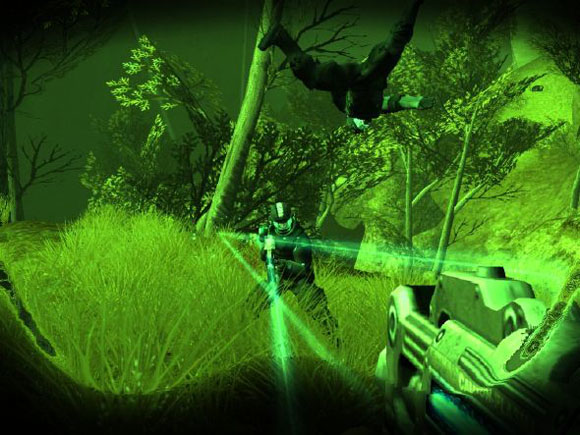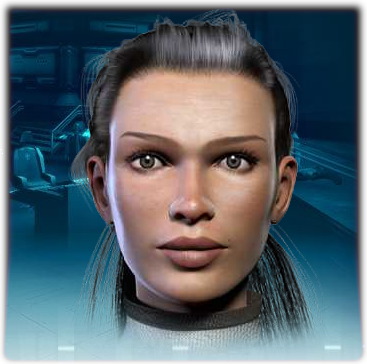CDM’s resident game composer W. Brent Latta talks to Tim Larkin, the composer behind the eagerly-anticipated, upcoming Myst 5 and the current PC/Xbox title Pariah, and featured in the live game music performance festival Video Games Live. (Sound samples at his site for both games; watch this space for updates on the Myst soundtrack and game.)
Brent got to talk to Tim about all aspects of music making, including the upcoming Myst 5 score. That game will live up to its title, End of Ages, as Cyan closed shop this month. But we expect the Age of Tim Larkin to be just beginning. Read on for more.

Ed: Updated — Cyan appears to have escaped an untimely death. Hope this means we can look forward to more new Cyan games with Tim Larkin music. Stay tuned.
Create Digital Music: Hi, Tim – thanks for taking the time to speak with us. Can you give us a snapshot of your musical history and how you got into the game audio business?

Tim Larkin: I started out playing piano at age 4, and started playing trumpet in 4th grade. I was a music major in college, studying trumpet performance. After I graduated, I toured for several years, playing for a variety of bands and artists. I lived in the Bay Area at the time and eventually stopped touring and became a studio musician and played with orchestras, jazz bands, operas, musicals that would come into town, etc.
I was a solo artist on Warner Bros. Avenue Jazz label about 12 years ago and that’s when I got more into composition and began working at Broderbund as a composer and sound designer – around 1993 or 1994. They were the publishers for Cyan at the time. The first game I worked on was called The Playroom – a children’s game. Broderbund hired me because they were looking to expand their audio department, and I had a lot of live experience and commercial experience. I had just finished up some work with Ice T doing some RnB and Hip-Hop work – kind of ‘New Jack Swing’ – and Broderbund wanted to incorporate some of the stuff I was doing, so I was hired on.
Broderbund was one of the first publishers to start using live recorded music in games. The industry was just getting into digital audio during that time, so we had a live band come in and record. The Playroom was one of the first products to incorporate live recorded audio rather than synthesized music.
CDM: You’ve been working in the game audio industry for quite awhile. What elements of game audio have changed the most for you over the years?
TL: The most significant shift is the technology. For The Playroom, along with the digital recordings, I was still doing MIDI arrangements for the old FM chipsets you’d find on soundcards in those days. When I was hired on at Broderbund they wanted to make sure that I could handle it – composing for live recordings and also composing for General MIDI. Doing MIDI arrangements was one of the worst experiences and I don’t miss it at all!
So, what has changed the most since then is the technology: resolution, speed, number of available voices, etc. Sound cards now have all these extra voices, from 24 or 32 available for music, sound design and ambience. It’s incredible. And being able to stream from the drive has made a huge difference. You can have so much more going on…
Production values have come a long way, too. It started out with single voices because memory and processor were so limited, but now that the technology has caught up, what we can do is almost unlimited. There’s so much more that the processors can do and now we have the space available to do it.

CDM: I just downloaded the demo for Myst V and the audio and music are incredible. Can you tell us a little about it?
TL: The technology available now has given us the chance to have a much more dynamic environment. The original Myst only had something like 2 channels of audio – one for music and one for ambience. So when you wanted to bring in a sound effect, you would have to sacrifice either the music or the ambience. Now, we can bring in ambience and crossfade it with other sounds to make the environment much more live and real. It is always changing with various timings of different sound effects, so it is never the same. And with surround sound you get a soundscape that is much more realistic and immersive.
CDM: How did you get into the sound design side of things?
TL: I didn’t really have any experience other than knowing a lot about digital audio. When I was hired at Broderbund,, toward the end of the interview they said, “Oh and by the way, this job is about 50% sound design…Do you have any problems with that?” Of course I said, “No”. To me sound design is very similar to composing, just using different elements of sound instead of instruments to put together soundscapes.
CDM: Along those lines, can you tell us about some of your favorite studio or production tools that have helped shape your composition or design style?
TL: The tools are different for me in design and music – with composing music, the most significant thing is definitely the progression of sample libraries. They are still rapidly progressing, even month to month. The technology there has made it incredible to do orchestral stuff. String sounds, brass sounds and winds are all really close to being realistic. There are moments where it is difficult to tell the difference.
It can be distracting at times to be sitting there tweaking controllers and picking the right samples and playing in a certain way, so in the beginning it adds time to the production cycle, but once you get comfortable with the library or palette you are planning on using, it becomes much more streamlined. I use Digital Performer for composing the music. Unfortunately, for Myst V, we didn’t have a budget for a full orchestra. I would have loved to have used a real orchestra, but with the limited time and resources I had to manipulate the orchestral samples I was using to make it sound right.
For sound design it is definitely ProTools – with all the plugins and tracks available it is a great tool for sound design.
CDM: Do you treat those as separate entities?
TL: They both run on the same machine, but I have machines that do other kinds of stuff. I try to stay away from the PC platform for the most part, but I do use a PC for Gigastudio and and for running the actual game engine.
CDM: Is Giga your primary sampler?
TL: It is for the most part. I use Kontakt and Kompakt within Digital Performer as well, but for most of the big sample libraries I use Gigasampler. I use Sonic Implants for strings. SAM puts out some great stuff too for brass. But definitely check out Sonic Implants. I’ve been working with them for a long time and I think they put out some great libraries.
CDM: From a composition and production standpoint, how have the tools available in today’s highly digital studio environment changed the way you compose and create music?
TL: Everything is just more available – anything that you want to hear you can get. When I started, if you wanted a good orchestral sound it just wasn’t realistic. You could do mock-ups and fake it, but it was never as detailed as it is now. With the speed and power available these days, everything from composition to mixing to mastering can be done on the desktop.
When I was first working at Broderbund we had little cubes to work in most of the time, and then a separate studio to go and mix and record in. But everything now can be done at one audio station. It’s all done inside the computer, sitting at your desk without the need for a big studio with tons of outboard gear. So everything is very compacted.
CDM: Getting more specific about game audio: Has composing music for games changed your composition or thought process?
TL: Yes – it has in the sense that what I was doing before was a very different idiom. I was writing jazz tunes and music for other artists while doing a lot work in the pop music field and in advertising, so a lot of what I was doing was very performance oriented. When I got into games, and later when I started working for Cyan, the music and soundscape needed to compliment and not distract from the game experience. Up until then I was writing music designed to be in the forefront instead of more in the background and as an atmosphere enhancer.
CDM: I suppose being a music major you had a lot of experience composing and orchestrating. Is there ever a time where you want to go back to the books and study more?
TL: All the time. I would love to go back and take more orchestration and arranging and composition courses. Unfortunately time doesn’t allow it. You learn the most by doing and by listening to others. I’m constantly listening to other soundtracks and sound designers. I just listen to enough material to where I hope it soaks in whether I’m aware of it or not.
For example, I have a request from someone who wants me to do some music similar to Pirates of the Caribbean, so I’ll listen to the soundtrack in the car in the background while I’m driving. I listen to a lot of Thomas Newman – he’s very innovative and doing stuff I really enjoy. I do what I like to call subliminal listening.
CDM: In a given project – lets use your two most recent projects, Pariah and Myst V – what level of interaction do you have with the programmers and developers in terms of actually implementing the music into the game engine?

 TL: The two games couldn’t have been more opposite in how I interacted with the development process. For Pariah, the music was basically outsourced – they asked me to provide “X” amount of music and we discussed the style and amount of time for each piece – whether it would be “combat” or “ambient”, etc. It was more talking about the style and the duration, and then I just composed and submitted the music. They did all the implementation on their end. But it was a really fun experience and I’d love to work with them again.
TL: The two games couldn’t have been more opposite in how I interacted with the development process. For Pariah, the music was basically outsourced – they asked me to provide “X” amount of music and we discussed the style and amount of time for each piece – whether it would be “combat” or “ambient”, etc. It was more talking about the style and the duration, and then I just composed and submitted the music. They did all the implementation on their end. But it was a really fun experience and I’d love to work with them again.
With Myst V I see the game through all levels of production, I compose the music where I think it needs it, and create the sound design how I think it works best. I will also get together with Rand (Miller) from time to time and discuss different ideas we have in each age and go from there.
A good example of one of Rand’s concepts is the first piece I released for the game on the Ubi website – I think a lot of people disliked it. It was for an Age where warriors or fighters kill beasts for the valuable stones in their bodies. It was a very warlike Age and the music I wrote had a very Middle Eastern and militaristic feel. I was getting comments saying, “This doesn’t sound like Myst.” But it is. This is now part of this story, part of the history of this Age. There’s darkness there and violence. Even though there’s no violence in the game itself, you try to reflect that history and backstory in the music.
So as Rand and I talked about it he said, “You know what, I think we need trumpet in this Age.” So I wrote the main themes with a very simple trumpet melody that has a kind of militaristic cadence. It is very different for Myst, while retaining familiar textural qualities to it. Its not easy blending those types of elements together while still fitting in the Myst mold.
It is also a challenge in a franchise like Myst where there is a loyal following of fans who expect things a certain way. With Uru I was able to depart from the Myst style a bit and take off in a different direction. At that time there were a lot of people who said it should have been Robin (Miller)’s music, and I understand where they’re coming from, that’s fine. But change happens. It has evolved to become a different story and different game. Change can be good if you have an open mind.
CDM: Can you tell us a bit more about the projects you’re working on now or have recently completed?
TL: Well, the Myst V soundtrack is coming – the CD’s should be in soon. We’re planning on releasing it right alongside the game. I think we have a press release coming out next week. There’s about 50 minutes of music on there.
There are a lot of new projects I’m working on now as well. For example, I’m working with Valve doing some sound design for their episodic content for Half Life. I just finished working on NBA 2006 doing some mixing in San Diego. Unfortunately, I can’t say much about other projects. It is frustrating as the industry really likes to keep things under wraps and so I’m under NDA. I also just did some trumpet recording for another American Experience documentary about the Vietnam War airing on PBS in October.
CDM: In the days of yore, being a musician and getting your music recorded and produced was extremely difficult. These days, digital music has become such a commodity because the cost of entry is so low. With the glut of available software and hardware, and the sheer volume of music being created these days, what advice can you offer aspiring musicians and composers in creating a unique voice or memorable impression on their listener?
TL: I get a lot of demos from people wanting to work on a Myst game or work for Cyan and I’ll tell you that 99% of the demos I get sound the same. They’re not bad, but I can’t tell one from another. Here’s another guy trying to be John Williams or here’s another guy trying to be Hans Zimmer. I try to listen to a lot of stuff and I don’t hear much that is unique out there. Not to say that these are bad composers at all, but there are a lot of mimics out there. That’s another reason I like Thomas Newman – because he’s cutting edge and pushing the envelope.
I don’t know if I’ve been successful in being unique myself, but I know I compose differently because of my background. I’m not a great orchestral composer and I don’t think about rules as much. I listen subliminally and pick up a certain orchestration or rhythm, but I don’t break apart scores and emulate like that.
What I try to do is start with what I feel comfortable with – a chord change, rhythm or melody. And I’ve even tried to change that to get a different perspective on writing. You have to try to think outside of yourself. You shouldn’t always do things the same way using one process that works for you. Try to stretch and change the actual process each time.
That’s why I love freelance stuff. For example, I’ve been doing everything from recording sessions for films to playing live in the studio band for the Survivor Palau Finale. I’ve also been doing sound design and music for various games from shooters to kids games like The Incredibles, Rugrats, and Clifford The Big Red Dog. It’s nice to have a fresh perspective. If you continue with a certain series of music, like Myst for example – I’ve been working in the Myst franchise for around 10 years– you have to try and keep a fresh perspective from somewhere else.
My advice would be – experience a lot of different styles and venues to keep your own perspective fresh. The way you do it, what you do and what you listen to. John Williams is great, don’t get me wrong, but there is a certain Hollywood formula that directors and even some game companies are skittish in breaking out of. But I think we have more possibilities with games because the industry is young and really still trying to finding it’s own groove.
CDM: Thanks very much for your time, Tim – we really appreciate it. Best wishes!